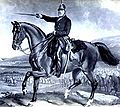5th Dragoon Guards facts for kids
Quick facts for kids 5th Dragoon Guards (Princess Charlotte of Wales's) |
|
|---|---|
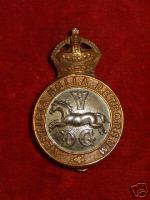
Badge of the 5th Dragoon Guards
|
|
| Active | 1685–1922 |
| Country | |
| Branch | Army |
| Type | Cavalry of the Line |
| Role | Heavy Cavalry |
| Size | 1 battalion |
| Nickname(s) | The Green Horse The Green Dragoons The Old Farmers |
| Motto(s) | Vestigia nulla retrorsum (Latin – We do not retreat) |
| March | (Quick) The Gay Cavalier (Slow) Soldier's chorus from Gounod's Faust |
| Anniversaries | Salamanca Day |
| Engagements | The Boyne 1690 Blenheim 1704 Ramillies 1706 Malplaquet 1709 Salamanca 1812 Balaclava 1854 |
| Battle honours | Blenheim, Ramillies, Oudenarde, Malplaquet, Beaumont, Salamanca, Vittoria, Toulouse, Peninsula, Balaklava, Sevastopol, Defence of Ladysmith, South Africa 1899–1902; France and Flanders 1914–18 |
| Disbanded | 1922 |
| Commanders | |
| Notable commanders |
1st Earl Cadogan 7th Earl of Cardigan |
The 5th (Princess Charlotte of Wales's) Dragoon Guards was an important army cavalry regiment in Britain. It was first formed in January 1686. Back then, it was known as Shrewsbury's Regiment of Horse.
Over the years, the regiment changed its name several times. In 1804, it became the 5th (Princess Charlotte of Wales's) Regiment of Dragoon Guards. This name was later shortened.
In 1922, this regiment joined with another one, The Inniskillings (6th Dragoons). They formed a new unit called the 5th/6th Dragoons. Today, the traditions and history of the 5th Dragoon Guards live on in the Royal Dragoon Guards, which is a modern armoured cavalry unit in the British Army.
Contents
A Look at Their History
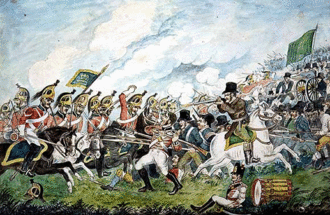
The 5th Dragoon Guards started on January 1, 1686. It was made up of several smaller groups of horse soldiers. These groups were first put together to help stop the Monmouth Rebellion in 1685.
After the Glorious Revolution in 1688, the regiment fought in the Williamite War in Ireland. They took part in important battles like the Battle of the Boyne. They also fought in the First Siege of Limerick.
When the Nine Years' War ended in 1697, the regiment was sent to Ireland. They stayed there for many years, becoming part of the Irish military. This continued until the United Kingdom was formed in 1801.
Fighting in Europe
During the War of the Spanish Succession, the regiment was led by William Cadogan. He was a close helper to the famous Duke of Marlborough. The regiment fought in many of Marlborough's big battles. These included Blenheim, Ramillies, and Malplaquet.
After the war ended in 1713, the regiment went back to Ireland. They spent most of the next 80 years on duty there.
Changes and New Battles
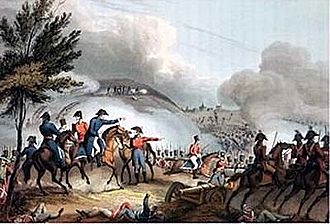
In 1746, the regiment was renamed the Second Irish Horse. Then, in 1788, it became the 5th Regiment of Dragoon Guards. When the French Revolutionary Wars began in 1793, they were sent to Flanders. There, they fought in the Battle of Beaumont in April 1794.
The unit then returned to Ireland. They helped to stop the Irish Rebellion of 1798. They fought in battles like Arklow and Vinegar Hill. In 1804, the regiment was renamed again. It became the 5th (Princess Charlotte of Wales's) Regiment of Dragoon Guards. This was in honour of Princess Charlotte.
Heroic Charges and Later Wars
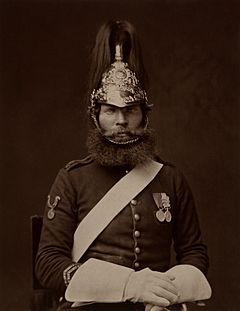
In 1810, the regiment was sent to Spain. They were part of Le Marchant's group during the Peninsular campaign. The Battle of Salamanca in July 1812 was a huge victory. It is seen as one of Wellington's greatest successes. Le Marchant's attack there was incredibly powerful.
The regiment celebrated 'Salamanca Day' every year until it was disbanded. This tradition is still carried on by some British Army units today.
Later, the regiment was sent to the Crimean War in 1853. They fought in the famous Battle of Balaclava in October 1854. The 'Charge of the Heavy Brigade' was a well-known event. The 5th Dragoon Guards had 15 soldiers killed or wounded in this charge.
A small group from the regiment joined the Nile Expedition in 1885. Their next major action was during the Second Boer War (1899–1902). They fought in battles like Elandslaagte and Ladysmith.
The First World War and Beyond
During the First World War, the regiment was part of the British Expeditionary Force. They landed in France in August 1914.
In 1921, they were officially renamed the 5th Dragoon Guards (Princess Charlotte of Wales's). The next year, in 1922, they joined with the Inniskillings (6th Dragoons). This formed the new unit called 5th/6th Dragoons.
Regimental Museum
The history and items of the 5th Dragoon Guards are kept at the Cheshire Military Museum. This museum is located at Chester Castle.
-
Memorial window at St Macartin's Cathedral, Enniskillen
-
J Whiston, 5th Dragoon Guards; gravestone, St Mary's Church, Eccleston
Important Leaders: The Colonels
The colonels were the main leaders of the regiment. Here are some of the notable ones:
-
Earl of Shrewsbury
1686-1687 -
William Cadogan
1703-1712 -
Viscount Cobham
1744-1745
See also
Sources








